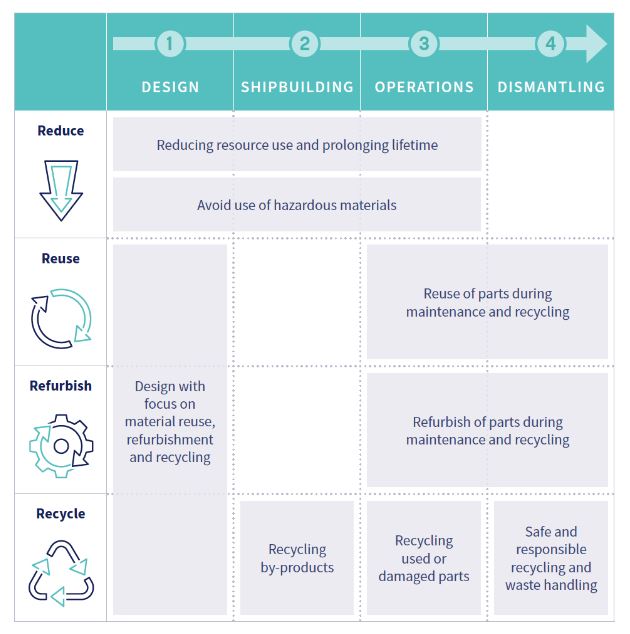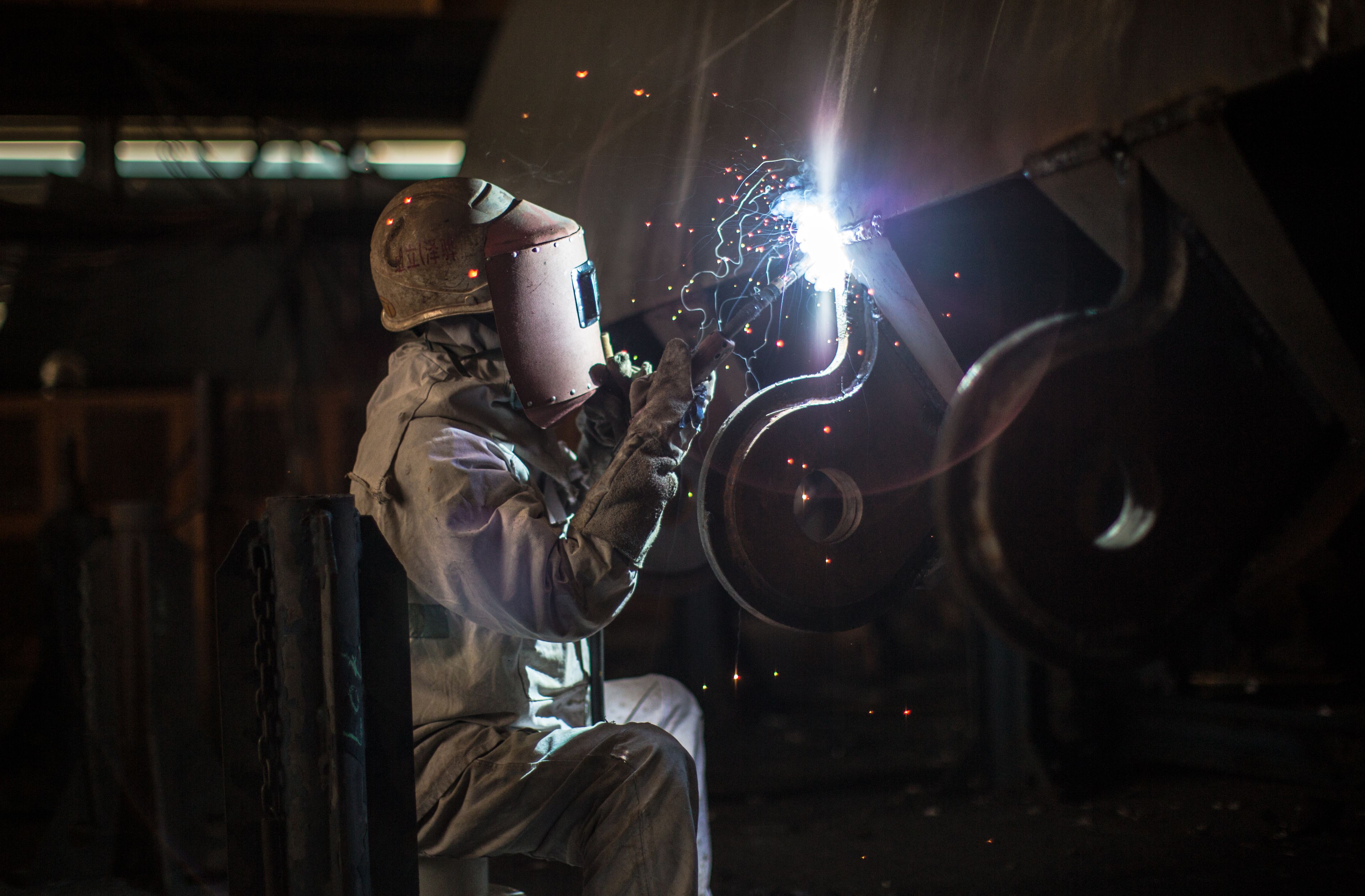Shipping’s fragmented way of operating, where shipbuilding, operating, and recycling happen in silos, is not optimal from a circularity perspective. The global energy transition thus presents a great opportunity to reconsider the way we design and build ships, the materials used, and how they are recycled at end-of-life. By doing this sooner rather than later, shipping can address a major source of Scope 3 emissions, become more resilient in the face of future changes, and do its part to achieve the Paris Agreement goal of limiting warming to below 1.5°C.
Window of opportunity
Shipping’s decarbonisation has accelerated innovation within shipping, as new fuels, technologies, and countless measures to increase fuel efficiency are developed and scaled. New regulation, such as the EU’s Fit for 55 package and the Corporate Sustainability Reporting Directive (CSRD), have implications for shipping at a regional level and highlight the importance of addressing Scope 3 emissions. This presents a crucial moment to review how shipping operates and utilises resources.
In addition to this, growing recognition of the broader sustainability scope beyond fuel emissions further points to the need to build a shared understanding around shipping’s role within the sustainability transition and key concepts such as circularity.
Circular shipping
Currently, around 95% of a vessel’s greenhouse gas (GHG) emissions arise from fuel combustion. But as shipping embraces alternative fuels, attention will shift to the remaining emissions from materials and shipbuilding. The key to decarbonisation lies in embedding circularity principles at every stage of the vessel lifecycle: from design and construction to operations and recycling.
A circular economy is defined by the Ellen MacArthur Foundation as “an economy that is based on the principles of designing out waste and pollution, keeping products and materials in use, and regenerating natural systems. As a result, the economy is restorative and regenerative by design”.
The Sustainable Shipping Initiative (SSI) identified a 4R hierarchy for shipping (from most to least desirable): Reduce, Reuse, Refurbish, and Recycle. We further explored ways in which these concepts could be applied across a ship's lifecycle, including prolonging the lifetime of individual components, designing for recycling, and reuse of parts during maintenance and recycling.
However, when considering how vessels can become more circular, we cannot ignore the opportunity presented by steel.
Responsible for 7% to 9% of global CO2 emissions, steel production is one of the largest contributors to the climate crisis. On a ship, steel accounts for 75-85% of a vessel’s weight. Thus, in order to fully decarbonise shipping we must understand how steel’s emissions can be reduced.
Efforts are ongoing to decarbonise steel, and terms such as net zero steel, zero carbon steel and many others are currently used in lieu of a common terminology and definition. SteelZero defines green steel as “certified as meeting the highest levels of environmental, social and governance performance (ESG), rather than only addressing the release of greenhouse gases”, though there is potential for a definition to be developed for a holistic term such as ‘sustainable steel’ which considers clear emission reduction thresholds as well as environmental, social and socioeconomic sustainability aspects.

Steel and shipping
Shipbuilding (and thus steel) contributes only around 3% of a vessel’s lifecycle emissions. However, this percentage will increase as operational emissions decrease, creating an incentive to start addressing and reducing these emissions now.
Currently, shipping-grade steel is seen as a desirable source of scrap due to its high quality, but in many cases, it is downcycled or mixed with lower quality steel to make new products, losing some of its value. By taking circular economy principles into consideration, we can maximise the value of steel at end-of-life – either by ensuring it is reused within the shipping sector (closing the physical loop) or as high-quality scrap elsewhere (closing the net loop).
Better steel in shipbuilding
In addition to better reuse of steel at end-of-life, we can increase our focus on the shipbuilding phase. As a steel buyer, shipping can join sectors such as automotive, construction, and renewable energy infrastructure in demanding action from the steel industry through initiatives like The Climate Group’s SteelZero, which builds demand for net zero steel. The ResponsibleSteel standard also looks to support the responsible sourcing and production of steel against a number of criteria across environmental, social, and governance issues.
Significant emissions reduction can be achieved by using more scrap in steel production. Fortunately, steel can be recycled without compromising its quality, and it is possible to produce shipping-grade steel made primarily, or entirely, with scrap steel – as long as the scrap is of a high enough quality. Unfortunately, the supply of scrap steel is limited. Collaboration between the shipping and steel sectors is therefore key, and understanding how shipping can act as a supplier of high-quality scrap has the potential to unlock benefits for both sectors.

Make it traceable
One of the main barriers to improving material use in shipping is the lack of traceability and transparency across a vessel’s lifecycle. As vessels have a long lifespan and may change hands numerous times (all the way to end-of-life where they may be sold to a recycling yard by way of a cash buyer), it’s difficult to keep track of materials. The problem is similar for steel, as there is a lack of traceability on the composition of steel at the shipbuilding phase (% of scrap used and sources of that scrap) and at the recycling phase (What sectors does the steel go to? How is it sorted?).
Building this transparency and traceability is critical for improving the flow of steel in shipping and retaining and maximising value.
Shipping is part of a global system
As the world continues to experience the impacts of rising temperatures, it’s impossible to ignore shipping’s place and impact within the global economy. Unlike the oil sector, shipping and steel are not facing an existential threat, and it seems safe to assume that shipping will have an important role to play in any future scenario. However, that creates an urgency to adapt, mitigate the impacts of the climate crisis, and build a resilient shipping sector that can continue to power supply chains for decades to come.









